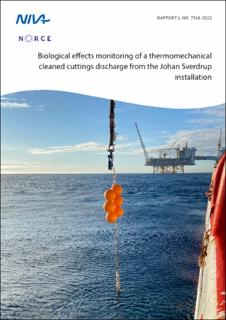Biological effects monitoring of a thermomechanical cleaned cuttings discharge from the Johan Sverdrup installation
Research report
Published version
Permanent lenke
https://hdl.handle.net/11250/3027260Utgivelsesdato
2022Metadata
Vis full innførselSamlinger
- NIVA-rapporter [6992]
- Publikasjoner fra Cristin - NIVA [2149]
Sammendrag
The following study describes an integrated biological effects monitoring programme using field transplanted mussels to determine the potential effects of thermomechanical cleaned cuttings (TCC) discharged from the Johan Sverdrup installation in the North Sea. Chemical body burden (PAHs, metals) and a suite of biological effects markers were measured in mussels positioned at strategic locations in the Johan Sverdrup field for 6-7 weeks and compared to two reference locations and a day zero (T0) group. The biomarkers measured in the mussels included: condition index (CI); stress on stress (SoS); micronuclei (MN); lysosomal membrane stability (LMS); metallothionein (MT) and gill and digestive gland histology. Based on oceanographic parameters, the DREAM model was employed to predict, and then later confirm, the direction of the TCC plume during the discharge period. Exposure to the TCC was limited to a 3-day window at the end of the mussel exposure but this was considered representative of the sporadic nature of the TCC discharge. PAH body burden in mussels was low in all mussel groups positioned at the Johan Sverdrup installation, although slightly above the reference and day zero mussel groups. Metal concentrations were either on or below the lower limit of the Norwegian classification scale for metal concentrations in mussel tissue indicating insignificant risk. Overall, the biomarker responses were considered low and did not differentiate significantly between the mussel groups. The Principal Component Analysis (PCA) showed no clear association between the chemical and biological responses in mussels and proximity to the Johan Sverdrup installation. The short duration of exposure to the TCC discharge may be partly responsible for the lack of chemical accumulation and biological response observed.
Beskrivelse
Prosjektleder Steven Brooks
